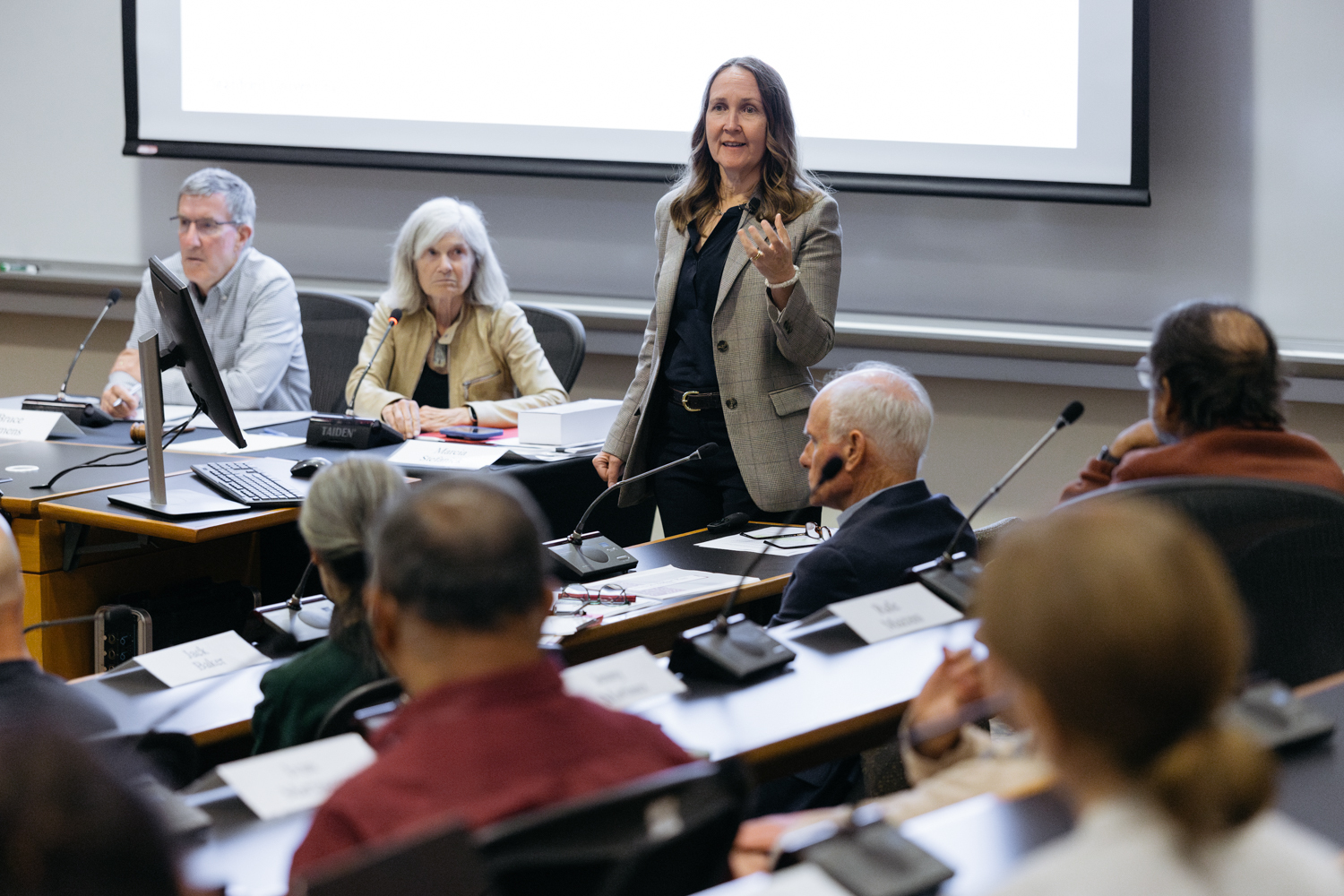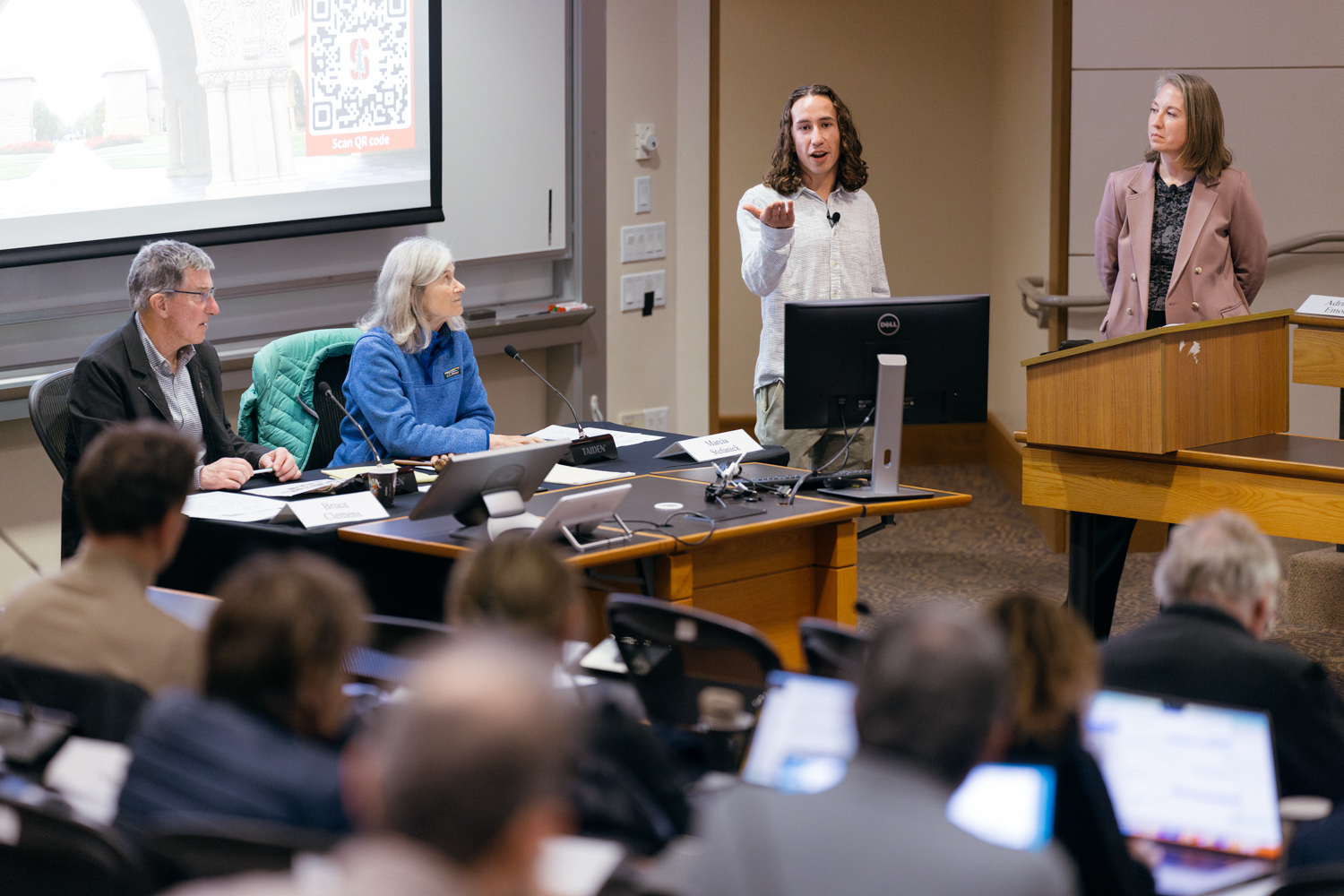Cuts to university spending are likely to be announced this summer as Stanford confronts federal funding risks and uncertainties, Provost Jenny Martinez told the Faculty Senate on Thursday in her annual budget presentation.
Martinez presented a “modified continuing resolution budget” for the 2025-26 year, a provisional spending plan developed this spring that largely mirrors current-year spending with small adjustments. Given the significant revenue risks the university faces, the university’s Budget Group will continue to meet this month to review scenarios prepared by schools and units for meaningful budget reductions. The Budget Group advises the provost and consists of faculty members from different schools along with senior staff. Former President Richard Saller and former Provost John Etchemendy, who have led this year’s Simplifying Work at Stanford initiative, are also working with the Budget Group and provost.
Martinez explained the principles guiding the Budget Group’s decision-making. The university will prioritize support for the core mission of research and education; look for ways to be leaner and more efficient; and position the university to be resilient in a variety of scenarios depending on how federal policy evolves.
“There is a wide range of uncertainty, but we could experience policy changes that would reduce our operating budget by hundreds of millions of dollars a year,” Martinez said. “That requires us to focus on expense reductions and to think creatively about our operating model and areas where we may need to reallocate resources.
“For example, an endowment tax will heavily impact undergraduate financial aid,” Martinez continued. “We intend to continue the generous aid we currently provide, but that will require moving money from other areas to fill in the gap. The same applies to graduate students, where we have a firm commitment to ensure five years of support at Stanford, or to backstop junior faculty who might be adversely affected by changes in federal research funding.”
Although federal policy changes are still in progress, given the likelihood and potential magnitude of impact, the university needs to plan prudently with cuts this summer to ensure that resources can be deployed to support the most critical needs.
The Faculty Senate also heard a report from the Ad Hoc Committee on the Faculty Senate on Academic Freedom and Censure.
It was the last Faculty Senate meeting of the 2024-25 academic year, and outgoing Senate Chair Marcia Stefanick received a standing ovation from senators as well as engraved gavel for her work leading the senate through a challenging year.
Funding risks
Martinez outlined the potential budgetary impact of several federal funding risks, including cancellation of existing federal research grants, reduction of the indirect cost rate, an increase of the endowment excise tax on investment returns, and reductions of future federal research funding.
For example, if the indirect cost recovery rate was reduced to 15% and the excise endowment tax increased to 21%, it would result in an estimated $637 million impact to Stanford’s annual budget.
There is also a risk of reduced direct research funding from the National Institutes of Health, Department of Energy, and National Science Foundation. Current proposals in Washington call for a significant reduction, but historically there has been bipartisan support for most direct research. Stanford currently receives $2.2 billion in federal research funding.
Substantial cuts to research funding could seriously weaken U.S. competitiveness and innovation, to which Stanford has made key contributions, Martinez said. In addition to reducing the pace of scientific discovery in fields like AI and biomedicine, the negative effects of such funding cuts on students will affect the pipeline of future scientists.
“There is simply no substitute for federal research funding for science,” Martinez said. “Even a university as well-resourced as Stanford would not be able to support research at the same level if there were those types of direct cuts to federal funding for science.”
In addressing these challenges, Stanford’s budget group is drawing on lessons learned during the 2008 global financial crisis. In the 2009-10 and 2010-11 budget plans, the endowment payout was cut by 25% over two years and the general funds budget by 15%.
“The cuts in the 2008 crisis were extremely painful, but by acting swiftly and decisively, Stanford was able to put itself in a strong position going forward,” Martinez said. “As difficult as this moment is, I am confident Stanford will navigate these challenges in a way that ensures continued excellence in research and education.”
Looking ahead, the budget group plans to have final decisions on general funds and potential cuts completed by July and report on major variances throughout the fiscal year. It also continues to simplify administrative burden, find efficiencies, and closely monitor the development of the federal budget.
Ross Shachter, associate professor of management science and engineering, asked Martinez about how plans to increase the undergraduate class size may be impacted by the budget plan.
Martinez said the committee that is considering the implications of expanding the undergraduate class is looking at potential budget scenarios and determining the feasibility of different class increases.
Jonathan Berk, the A.P. Giannini Professor of Finance at Stanford Graduate School of Business, said he believes the university needs to reconsider how it communicates its value to the public. “We have taken for granted that the rest of the country appreciates what we do and what it means for American growth,” he said.
Martinez agreed, stating that declining public support and confidence in universities must be addressed. “As President Levin has said, we need to get to a place where, ten years from now, it doesn’t matter who is in the White House or which party controls Congress, that we enjoy such widespread public support that universities will be viewed as an asset to the country, and spending on things like scientific research will be viewed as an investment in something that is important for the country,” Martinez said.
Leadership updates
On Monday, Stanford filed an amicus brief in the Harvard research funding case along with 23 other research universities, said President Jonathan Levin. This is the district court stage of a case that may continue through the appellate courts.
“The brief articulates the value of university research and its contribution to American innovation, using examples from Stanford and other campuses,” Levin said. “It highlights the interdependence of universities and the federal government in advancing knowledge and national economic leadership.”
The university is also working with a coalition of universities to propose an alternative to the endowment tax provision in the recent tax bill advanced by the House of Representatives, Levin said. The alternative would focus on placing a minimum payout requirement on university endowments, similar to the rule on foundations, with a tax rate close to the existing rate in the 2017 tax bill.
Levin also said he attended the second event in the Stanford Open Minds tour last weekend in San Francisco during which more than 800 alumni attended faculty research talks, a panel discussion on civil discourse, and a fireside chat with Lily Sarafan, incoming chair of the Board of Trustees.
Levin thanked senators for their work this year and said he looked forward to a joyous weekend with graduates, their families, and the university community at Commencement.
Academic freedom
The Faculty Senate voted to postpone a motion on due process for condemnations of faculty until a motion is voted on that will decide whether the senate has the power to condemn or rebuke.
The vote followed a report from the Ad Hoc Committee on the Faculty Senate on Academic Freedom and Censure. The committee was formed last year in response to concerns raised by a Planning and Policy Board report on the 2020 senate condemnation of Scott Atlas, a Hoover Institution fellow who advised President Donald Trump on COVID-19 matters. These concerns centered on academic freedom, the senate’s institutional authority, and the absence of due process when considering actions against individuals.
The committee was asked to reflect on whether the senate should have the ability to censure or condemn and if so, when and how it should occur. The answer is not obvious, and the committee disagreed on whether it was appropriate for the senate to consider condemnation, said Ad Hoc Committee Chair Amit Seru. Seru is the senior associate dean for academic affairs in the Graduate School of Business and the Steven and Roberta Denning Professor of Finance.
The committee recommended that the senate consider and clarify whether it has the institutional power and procedural foundation to consider a condemnation resolution. The committee also recommended that the senate affirm condemnation as a symbolic and extraordinary act, adopt a process-oriented framework to safeguard academic freedom and ensure fair treatment, and task future senate leadership with potentially drafting formal rules or legislation.
For more information
Seru is a senior fellow at the Hoover Institution and at the Stanford Institute for Economic Policy Research. Stefanick is a professor (research) of medicine, of obstetrics and gynecology, and, by courtesy, of epidemiology and population health.
Writer
Chelcey Adami







